 W
WAcanthite is a form of silver sulfide with the chemical formula Ag2S. It crystallizes in the monoclinic system and is the stable form of silver sulfide below 173 °C (343 °F). Argentite is the stable form above that temperature. As argentite cools below that temperature its cubic form is distorted to the monoclinic form of acanthite. Below 173 °C acanthite forms directly. Acanthite is the only stable form in normal air temperature.
 W
WAguilarite is an uncommon sulfosalt mineral with formula Ag4SeS. It was described in 1891 and named for discoverer Ponciano Aguilar.
 W
WAllargentum is a mineral from the class of antimonides, superclass of sulfides and sulfosalts, with formula written as Ag1−xSbx, where x = 0.09–0.16. This moderately rare mineral is found in silver ores and is therefore named from the Greek ἄλλος and the Latin argentum ("silver"). Its Vickers hardness is 172–203.
 W
WAndorite is a sulfosalt mineral with the chemical formula PbAgSb3S6.
 W
WAramayoite is a mineral with the chemical formula Ag3Sb2(Bi,Sb}}S6. Its type locality is Sud Chichas, Potosí, Bolivia.
 W
WIn mineralogy, argentite (from the Latin argentum, silver) is cubic silver sulfide (Ag2S), which can only exist at temperatures above 173 °C, 177 °C or 179 °C. When it cools to ordinary temperatures it turns into its monoclinic polymorph, acanthite. Argentite belongs to the galena group. Silver is extracted from the ore-argentite.
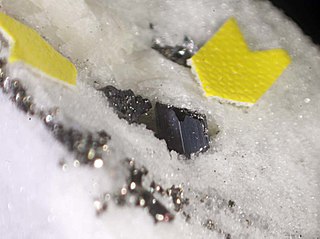 W
WArgentobaumhauerite is a rare mineral with the chemical formula Ag1.5Pb22As33.5S72. Its type locality is the Binn valley in Switzerland.
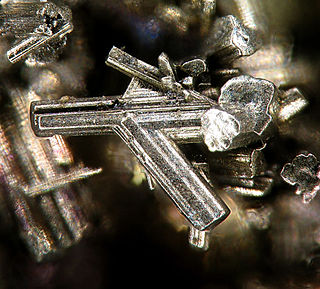 W
WArgentopyrite is a moderately rare sulfide mineral with formula AgFe2S3. It is one of the natural compounds of the M Fe2S3 type, with M being caesium in very rare pautovite, copper in relatively common cubanite, potassium in rare rasvumite and thallium in rare picotpaulite. The type locality is Jáchymov in Czech Republic. Chemically similar mineral include sternbergite (dimorphous with argentopyrite), lenaite, AgFeS2, and argentopentlandite, Ag(Fe,Ni)8S8.
 W
WArgyrodite is an uncommon silver germanium sulfide mineral with formula Ag8GeS6. The color is iron-black with a purplish tinge, and the luster metallic.
 W
WArquerite is a naturally occurring alloy of silver with mercury. It is a very rare mineral, consisting of a silver-rich variety of amalgam, containing about 87% silver and 13% mercury. Arquerite has been reported from only four localities worldwide, two in Chile and two in British Columbia, Canada. Other names for arquerite include argental mercury, mercurian silver, and silver amalgam.
 W
WAurorite is a dark-colored mineral with the chemical formula (Mn2+,Ag,Ca)Mn4+3O7·3H2O. It is named for its type locality, the North Aurora mine in White Pine County, Nevada.
 W
WBerryite is a mineral with the formula Pb3(Ag,Cu)5Bi7S16. It occurs as gray to blue-gray monoclinic prisms. It is opaque and has a metallic luster. It has a Mohs hardness of 3.5 and a specific gravity of 6.7.
 W
WBoleite is a complex halide mineral with formula: KPb26Ag9Cu24(OH)48Cl62. It was first described in 1891 as an oxychloride mineral. It is an isometric mineral which forms in deep-blue cubes. There are numerous minerals related to boleite, such as pseudoboleite, cumengite, and diaboleite, and these all have the same complex crystal structure. They all contain bright-blue cubic forms and are formed in altered zones of lead and copper deposits, produced during the reaction of chloride bearing solutions with primary sulfide minerals.
 W
WBromyrite or bromargyrite is a natural mineral form of silver bromide found mainly in Mexico and Chile. Hardness is 1.5 to 2. Related are chlorargyrite and iodyrite.
 W
WCanfieldite is a rare silver tin sulfide mineral with formula: Ag8SnS6. The mineral typically contains variable amounts of germanium substitution in the tin site and tellurium in the sulfur site. There is a complete series between canfieldite and its germanium analogue, argyrodite. It forms black orthorhombic crystals which often appear to be cubic in form due to twinning. The most typical form is as botryoidal rounded grape-like masses. Its Mohs hardness is 2.5 and the specific gravity is 6.28. Canfieldite exhibits conchoidal fracturing and no cleavage.
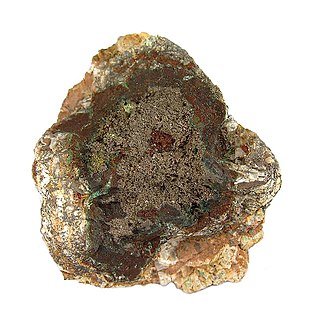 W
WChlorargyrite is the mineral form of silver chloride (AgCl). Chlorargyrite occurs as a secondary mineral phase in the oxidation of silver mineral deposits. It crystallizes in the isometric - hexoctahedral crystal class. Typically massive to columnar in occurrence it also has been found as colorless to variably yellow cubic crystals. The color changes to brown or purple on exposure to light. It is quite soft with a Mohs hardness of 1 to 2 and dense with a specific gravity of 5.55. It is also known as cerargyrite and, when weathered by desert air, as horn silver. Bromian chlorargyrite is also common. Chlorargyrite is water-insoluble.
 W
WCrookesite is a selenide mineral composed of copper and selenium with variable thallium and silver.
 W
WThe silver antimonide mineral dyscrasite has the chemical formula Ag3Sb. It is an opaque, silver white, metallic mineral which crystallizes in the orthorhombic crystal system. It forms pyramidal crystals up to 5 cm (2.0 in) and can also form cylindrical and prismatic crystals.
 W
WEmpressite is a mineral form of silver telluride, AgTe. It is a rare, grey, orthorhombic mineral with which can form compact masses, rarely as bipyrimidal crystals.
 W
WFettelite, also known as sanguinite, is a mercury-sulfosalt mineral with the chemical formula Ag16HgAs4S15. The mineral was first described by Wang and Paniagua (1996) who named it after M. Fettel, a German field geologist who collected the first samples from Odenwald. It was first collected in the Nieder-Beerbach mine, 10 km south of Darmstadt, Odenwald, Germany. Its normal occurrence is in hydrothermal veins, which can cut gabbro-diorite intrusives. It is closely related to other rare minerals like dervillite, daomanite, vaughanite and criddleite which are also found in the same type locality as fettelite.
 W
WFreibergite is a complex sulfosalt mineral of silver, copper, iron, antimony and arsenic with formula (Ag,Cu,Fe)12(Sb,As)4S13. It has cubic crystals and is formed in hydrothermal deposits. It forms one solid solution series with tetrahedrite and another with argentotennantite. Freibergite is an opaque, metallic steel grey to black and leaves a reddish-black streak. It has a Mohs hardness of 3.5 to 4.0 and a specific gravity of 4.85 - 5. It is typically massive to granular in habit with no cleavage and an irregular fracture.
 W
WFreieslebenite is a sulfosalt mineral composed of antimony, lead, and silver. Sulfosalt minerals are complex sulfide minerals with the formula: AmBnSp. The formula of freieslebenite is AgPbSbS3.
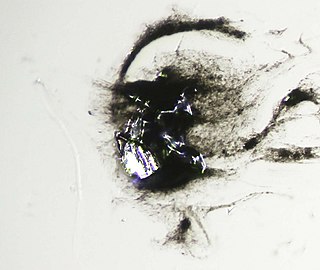 W
WGabrielite is a rare thallium sulfosalt mineral with a chemical formula of Tl6Ag3Cu6(As,Sb)9S21 or Tl2AgCu2As3S7.
 W
WHessite is a mineral form of disilver telluride (Ag2Te). It is a soft, dark grey telluride mineral which forms monoclinic crystals.
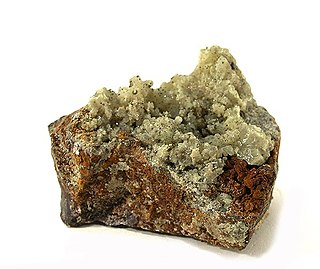 W
WIodyrite or iodargyrite is a natural mineral form of silver iodide.
 W
WJalpaite is a rare copper silver sulfide mineral with formula Ag3CuS2.
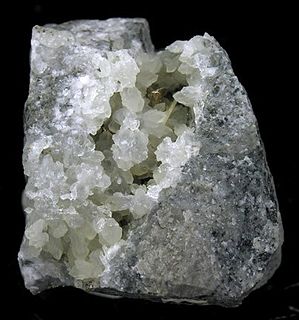 W
WKrennerite is an orthorhombic gold telluride mineral which can contain variable amounts of silver in the structure. The formula is AuTe2, but specimen with gold substituted by up to 24% with silver have been found ([Au0.77Ag0.24]Te2). Both of the chemically similar gold-silver tellurides, calaverite and sylvanite, are in the monoclinic crystal system, whereas krennerite is orthorhombic.
 W
WMarrite (mar'-ite) is depicted by the chemical formula PbAgAsS3. It is the arsenic equivalent of mineral freieslebenite (PbAgSbS3), but also displays close polyhedral characteristics with sicherite and diaphorite. Marrite was named in honor of geologist John Edward Marr (1857–1933) of Cambridge, England.
 W
WMiargyrite is a mineral, a sulfide of silver and antimony with the formula AgSbS2. It is a dimorph of cuboargyrite. Originally discovered in the Freiberg district of Germany in 1824, it has subsequently been found in many places where silver is mined. It usually occurs in low temperature hydrothermal deposits. and forms black metallic crystals which may show a dark red internal reflection. The streak is also red.
 W
WMoschellandsbergite is a rare isometric mineral made up of a silver-white amalgam of mercury and silver with the chemical makeup Ag2Hg3.
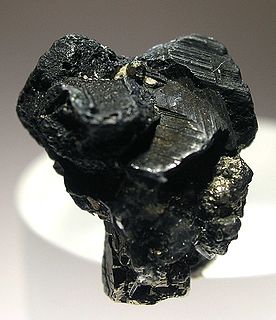 W
WPearceite is one of the four so-called "ruby silvers", pearceite Cu(Ag,Cu)6Ag9As2S11, pyrargyrite Ag3SbS3, proustite Ag3AsS3 and miargyrite AgSbS2. It was discovered in 1896 and named after Dr Richard Pearce (1837–1927), a Cornish–American chemist and metallurgist from Denver, Colorado.
 W
WThe mineral petzite, Ag3AuTe2, is a soft, steel-gray telluride mineral generally deposited by hydrothermal activity. It forms isometric crystals, and is usually associated with rare tellurium and gold minerals, often with silver, mercury, and copper.
 W
WPolybasite is a sulfosalt mineral of silver, copper, antimony and arsenic. Its chemical formula is [(Ag,Cu)6(Sb,As)2S7][Ag9CuS4].
 W
WProustite is a sulfosalt mineral consisting of silver sulfarsenide, Ag3AsS3, known also as light red silver or ruby silver ore, and an important source of the metal. It is closely allied to the corresponding sulfantimonide, pyrargyrite, from which it was distinguished by the chemical analyses of Joseph L. Proust (1754–1826) in 1804, after whom the mineral received its name.
 W
WPyrargyrite is a sulfosalt mineral consisting of silver sulfantimonite, Ag3SbS3. Known also as dark red silver ore or ruby silver, it is an important source of the metal.
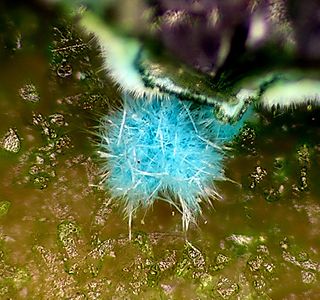 W
WQuetzalcoatlite is a rare tellurium oxysalt mineral with the formula Zn6Cu3(TeO6)2(OH)6 · AgxPbyClx+2y. It also contains large amounts of silver- and lead(II)chloride with the formula AgxPbyClx+2y (x+y≤2). It has a Moh's hardness of 3 and it crystallizes in the trigonal system. It has a deep blue color. It was named after Quetzalcoatl, the Aztec and Toltec god of the sea, alluding to its color. It is not to be confused with tlalocite, which has a similar color and habit.
 W
WSamsonite is a silver manganese antimony sulfosalt mineral with formula Ag4MnSb2S6. It crystallizes in the monoclinic crystal system with a typical slender radiating prismatic habit. It is metallic black to steel black with no cleavage and a brittle to conchoidal fracture. In thin fragments it appears reddish brown in transmitted light and also leaves a red streak. It is soft, Mohs hardness of 2.5, and has a specific gravity of 5.51.
 W
WStephanite is a silver antimony sulfosalt mineral with formula: Ag5SbS4 It is composed of 68.8% silver, and sometimes is of importance as an ore of this metal.
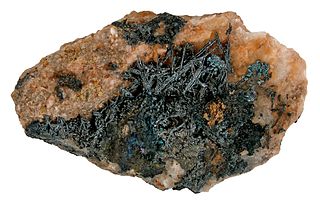 W
WStromeyerite is a sulfide mineral of copper and silver, with the chemical formula AgCuS. It forms opaque blue grey to dark blue orthorhombic crystals.
 W
WStützite or stuetzite is a silver telluride mineral with formula: Ag5−xTe3 (with x = 0.24 to 0.36) or Ag7Te4.
 W
WSylvanite or silver gold telluride, (Ag,Au)Te2, is the most common telluride of gold.
 W
WThe mineral uytenbogaardtite, Ag3AuS2, is a soft, greyish white sulfide mineral, occurring in hydrothermal Au-Ag-quartz veins. It occurs as tiny crystals, visible only with a microscope. It has a metallic luster and a hardness on the Mohs scale of 2 (gypsum).
 W
WXanthoconite is a sulfosalt mineral with the chemical formula Ag3AsS3.